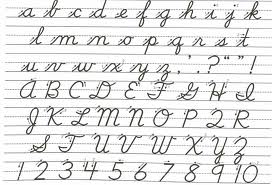Cursed Without Cursive?
 When preparing a speech, I encourage my clients to hand write their notes and scripts. There’s something about handwriting that helps you connect with your thoughts and themes. The technique is especially helpful when preparing slides for a speech. Rather than sitting down at a keyboard, start with a set of yellow sticky notes. Then write down your thoughts — one per page — and arrange the notes on a wall. You’ll think more clearly and connect thoughts more effectively. You’ll also create better slides, with less text and more flow.
When preparing a speech, I encourage my clients to hand write their notes and scripts. There’s something about handwriting that helps you connect with your thoughts and themes. The technique is especially helpful when preparing slides for a speech. Rather than sitting down at a keyboard, start with a set of yellow sticky notes. Then write down your thoughts — one per page — and arrange the notes on a wall. You’ll think more clearly and connect thoughts more effectively. You’ll also create better slides, with less text and more flow.
I never knew quite why handwriting worked so effectively. I just knew that it did. Then I stumbled across an article by William Klemm in Psychology Today about the importance of writing in cursive (as illustrated above). Klemm argues that learning to write cursive makes kids smarter. When learning cursive, “…the brain develops functional specialization that integrates both sensation, movement control, and thinking. Brain imaging studies reveal that multiple areas of the brain become co-activated during learning of cursive writing of pseudo-letters, as opposed to typing or just visual practice.” It also improves fine motor skills and gets kids to learn to pay attention more effectively.
Similarly, Susanne Baruch Asherson, writing in the New York Times, argues that “Cursive handwriting stimulates brain synapses and synchronicity between the left and right hemispheres, something absent from printing and typing.” Iris Hatfield, writing in New American Cursive, says there are ten reasons to learn cursive. Among them: increased speed, better fine motor skills, better self discipline, and improved self-confidence.
These articles are about teaching cursive to children. Do these benefits apply to adults? I encourage my clients to write drafts of their speeches (or press releases or white papers, etc.) by hand. I think most of them don’t take my advice — it just seems antiquated. But those that do, report positive results. Their communications are simpler and clearer. I also encourage my students to write drafts of their essays by hand. Again, most of them don’t take my advice. But I can generally guess which ones do. They turn in better papers.
So think about your communications. It’s a complex world and communicating effectively is a fundamental competitive advantage. Give cursive a chance. You may just find that you win more business.
I wonder if time also plays a role. Writing by hand takes so much longer than typing and permits more edit-style thinking during the writing process itself, potentially generating a more cohesive piece the first time around (then the regular editing process already has a head start and goes further in subsequent workings). I noticed this on a recent plane trip when I wanted to work on something prior to the allowance of electronic devices during the flight.
I agree. My daughters attend a Swedish Montessori school that emphasizes writing by hand; one of their study techniques is to copy down or paraphrase texts from a textbook into their own notebooks instead of simply reading. (I can objectively say as their mother that it makes them smarter!) I hope schools will learn that computers and keyboards in the classroom should be seen as aids, and not replacements for real writing.